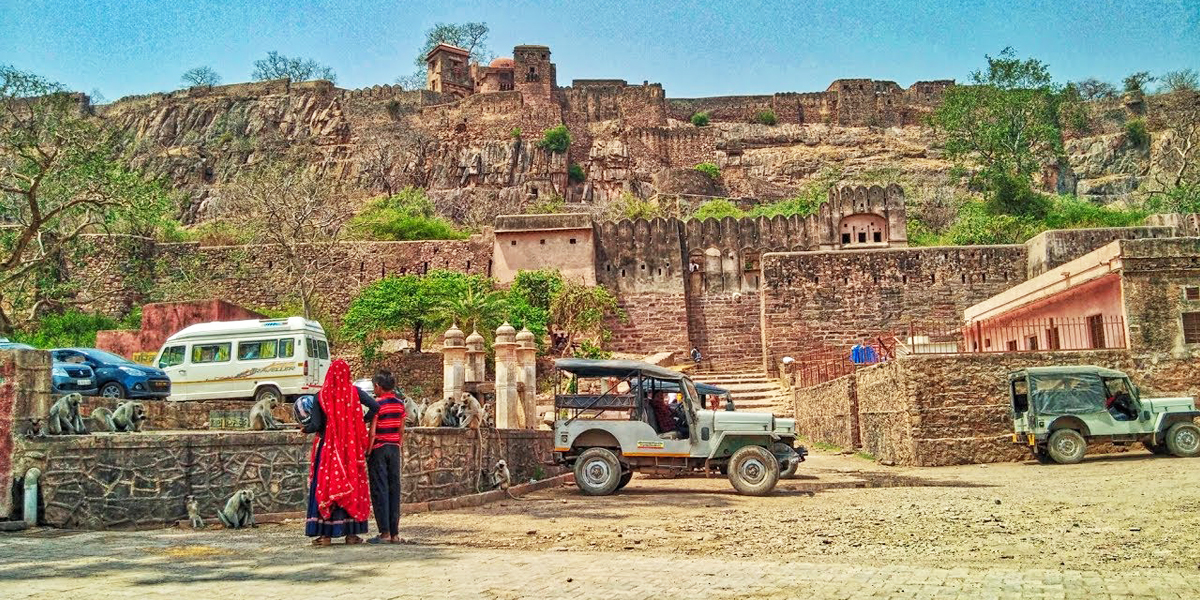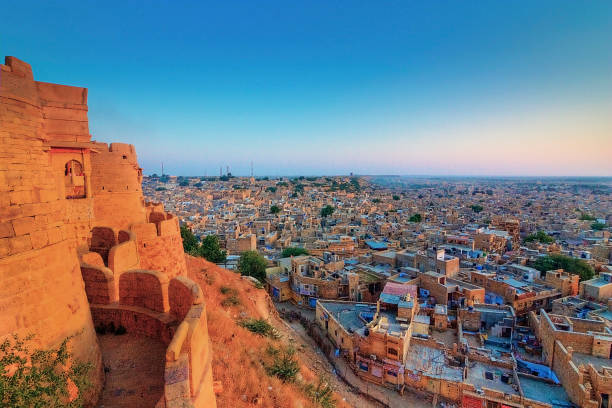Ranthambore Fort
Ranthambore Fort located within the Ranthambore National Park, near the town of Sawai Madhopur in Rajasthan. The fort has been declared as a world heritage site by UNESCO.

The remarkable Ranthambore Fort was built by the Chauhan rulers in the 10th century. Due to its strategic location, it was ideal to keep the enemy at bay.
Constructed in 944 AD, Ranthambore Fort has witnessed many sieges and battles. Probably the most famous among these is the war of Rao Hamir in 1301 against the Sultan of Delhi, Alauddin Khilji. An architectural marvel, the fort includes many attractions such include Toran Dwar, Mahadeo Chhatri and Sametonki Haveli within its premises.
The walls of the fort are about 7 kilometers in length and include an area of nearly 4 square kilometers. All around the fort, one can see many old ruins, including palaces, temples, cenotaphs, step-wells and houses.
The Ranthambore fort is surrounded by massive stonewalls which are strengthened by towers and bastions. The stone for the masonry was mined from inside the Fort and the mines were later turned into ponds for water storage.
The main approach to the Fort lies through a narrow valley, which had four fortified gateways. Of these, only the first gate - Misradhara gate, is still standing. There are many ruined buildings inside the Fort, with Hammir's Court, Badal Mahal, Dhula Mahal and Phansi Ghar being the most prominent of them. The Fort also has many cenotaphs, temples and gates.
The Ganesh Temple, which lies very close to the main entry gate to the Fort, attracts a steady flow of pilgrims, mainly from the rural hinterland. During the annual Ganesh festival, tens of thousands of pilgrims visit the temple, from all over the country.
Most of the visitors to the Fort tend to stay in the Western part of the Fort. Very few visitors go to the eastern part of the fort, which is nearly wild. A small perennial stream called Gupt Ganga flows in this part of the Fort. Here one can see a large number of birds, Langurs, the odd small cat and sometimes, even leopards. The fort is one of the best places to look for the very rare and elusive Fishing cat.
The fort is a must see for all visitors to Ranthambore. A good day to visit the fort is Wednesday, the day of the Lord Ganesh, when a lot of local people visit the Ganesh temple dressed in their best finery.
The oldest settlement in the area near Sawai Madhopur was around the Ranthambore fort. The exact origin of the Ranthambore fort is still disputed but it is generally accepted that there was a settlement at the site of the Fort, as far back as the 8th century A.D. It is widely believed that the construction of the Ranthambore Fort was started during the reign of the Chauhan rajput King Sapaldaksha in 944 AD. Another theory stipulates that King Jayant, also a Chauhan rajput, built the Ranthambore Fort during 1110 AD. It is most likely that the construction of the fort commenced during the mid 10th Century A.D. and continued for a few centuries after that.
Since, the Ranthambore Fort controlled the trade routes between North India and Central India; it was highly coveted by the rulers of North India. The Ranthambore Fort had its golden moments during the reign of the king Rao Hammir, the last ruler of the Chauhan dynasty (1282 - 1301 AD). During 1300 AD, Ala-ud-din Khilji, the ruler of Delhi sent his army to capture the Fort. After three unsuccessful attempts, his army finally conquered the Ranthambore Fort in 1301 and ended the reign of the Chauhans. In the next three centuries the Ranthambore Fort changed hands a number of times, till Akbar, the great Mughal emperor, finally took over the Fort and dissolved the State of Ranthambore in 1558. The fort stayed in the possession of the Mughal rulers till the mid 18th century.
During the mid 18th century, the Maratha rulers of Western India were gradually increasing their influence in this region. In order to check the growing influence of the Marathas, Sawai Madho Singh, the ruler of Jaipur state, unsuccessfully, requested the Mughal emperor to hand over the Ranthambore fort to him. In 1763, Sawai Madho Singh fortified the nearby village of Sherpur and renamed it Sawai Madhopur. This town, which is now commonly known as the "Sawai Madhopur City", lies in a narrow valley between two parallel hills, at the South Western edge of the Ranthambore National Park. Two years later, the Mughals handed over the fort to the Jaipur state.
During the end of the British Raj, Sawai Man Singh, the last ruler of Jaipur state, got a railway link constructed between Jaipur and Sawai Madhopur. A railway station was built about 4 kilometers away from the Sawai Madhopur town. Gradually, a small settlement came up around the railway station. This town of Sawai Madhopur, known as "Man Town", has now outgrown the older "City".
Ranthambore Fort is half an hour drive from Sawai Madhopur town. Private taxis are available on rent.
The best time to visit the Ranthambore fort is between the months of October and February before the scorching heat of the desert kicks in.
